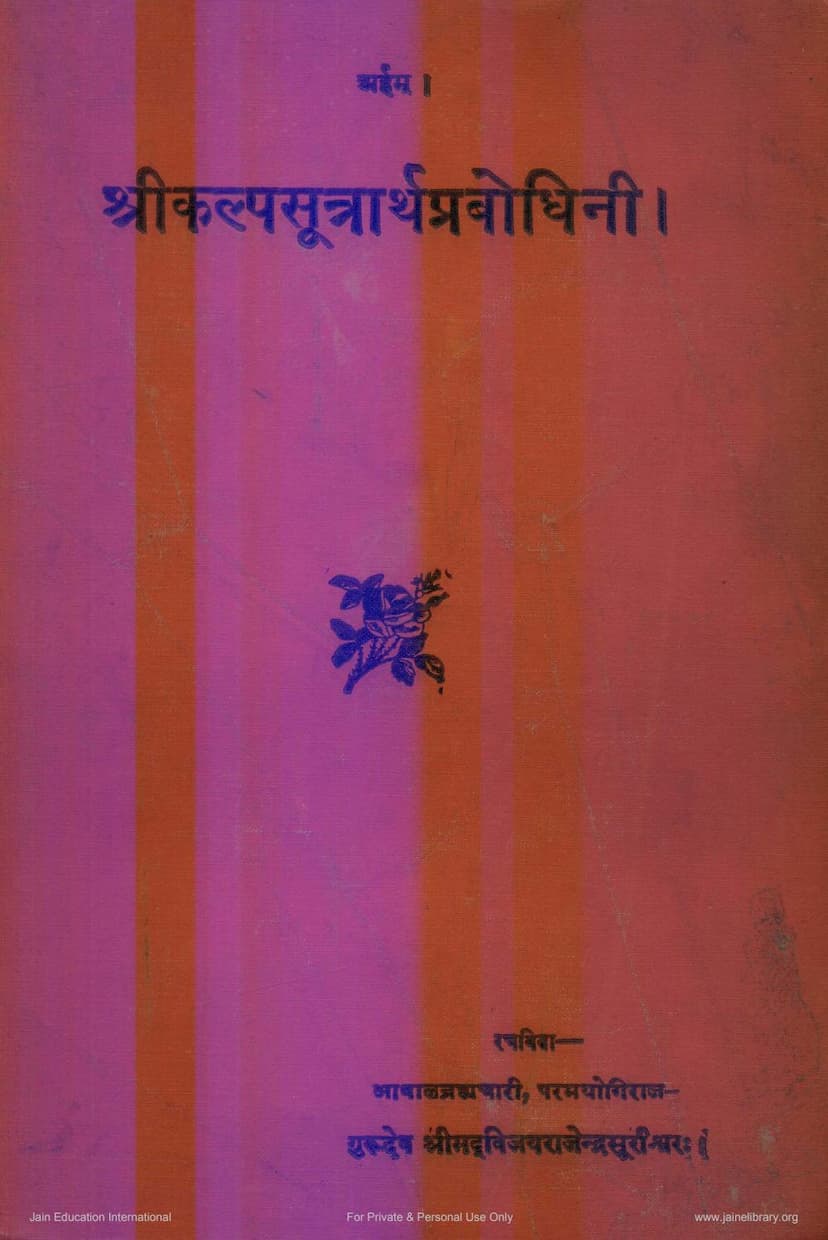Kalpasutrartha Prabodhini
Added to library: September 2, 2025

Summary
Here is a comprehensive summary of the provided Jain text, the "Kalpasutrartha Prabodhini," authored by Rajendrasuri:
Book Title: Kalpasutrartha Prabodhini Author: Acharya Vijayendrasuri Publisher: Rajendra Pravachan Karyalay, Khudala Catalog Link: https://jainqq.org/explore/002772/1
Overall Purpose:
The Kalpasutrartha Prabodhini is a commentary (Tika) on the Kalpasutra, a fundamental Jain text, particularly important during the Paryushana festival. The commentary aims to make the profound meaning of the Kalpasutra accessible to a wider audience, especially those who appreciate a simpler style of Sanskrit. It achieves this by explaining the intricate meanings of the original Prakrit text and its associated scholarly vocabulary in straightforward Sanskrit prose, enriched with illustrative narratives.
Author and His Legacy (Based on the Introduction and Biography):
The commentary is attributed to the highly revered Acharya Vijayarajendrasuri, a prominent Jain scholar and spiritual leader of his time. He is described with numerous epithets highlighting his mastery of Jain scriptures (sakal Jainagamaparadrashva), his spiritual prowess (paramayogiraj), his erudite scholarship, his role in reforming practices (kruddhodhar), and his deep devotion. He lived during a period when Jain practices were perceived to be declining, and he is credited with revitalizing them and clarifying scriptural interpretations. The text itself mentions his birth in 1883 (Vikram Samvat) and nirvana in 1963.
Key Features and Content of the Commentary:
- Accessibility: The primary goal is to elucidate the Kalpasutra's meaning in simple Sanskrit prose, making it easily understandable. The author explicitly states he has avoided complex grammatical structures and obscure terminology.
- Structure: The commentary is structured into nine vyakhyanas (lectures or expositions).
- Narrative Approach: To facilitate understanding, the commentary uses narrative explanations (charitra-rupana) for each section of the Kalpasutra.
- Biographical Content: The initial part of the commentary (Pages 7-38) is dedicated to the life and teachings of Acharya Vijayarajendrasuri himself, providing details about his birth, initiation, education, disputes, his significant contributions (like establishing rules for conduct - gacchmaryadapattak), his penances, his role in resolving social issues (like the chirola incident), and his final moments.
- Content of the Kalpasutra Explained: The commentary covers various aspects of the Kalpasutra, including:
- Rules of Recitation: Proper timings and procedures for reciting the Kalpasutra.
- Conduct of Ascetics (Sadhvichar): The text details the ten aspects of ascetic conduct.
- Lives of Tirthankaras: It provides biographical sketches of various Tirthankaras, with special emphasis on Lord Mahavir, Lord Parshvanath, and Lord Neminath, and a brief overview of others. It includes details of their births, ascensions, renunciations, and attainments.
- Key Jain Concepts: It delves into concepts like achalakya (asceticism, including rules about clothing), audeshika (things created for a specific monk), shayyatar (owner of the place where monks reside), rajapind (rules related to royal patronage or interaction), kritikarma (rituals), vratas (vows), jyeshtha (seniority rules), pratikraman (repentance rituals), masakalpa (monthly vows), and paryushana kalpa (rules during the Paryushana festival).
- Illustrative Narratives: The text extensively uses stories and examples (drishtanta) to illustrate the scriptural points. These include tales about the author's own miraculous powers and the resolution of social conflicts.
- The Author's Interpretations: The commentary presents Acharya Vijayarajendrasuri's specific interpretations on various scriptural matters, such as the meaning of "Vandan," the validity of the fourth stuti in certain contexts, the proper procedure for chaitra-vandana, and the rules regarding clothing (vastra-ranjan).
- Genealogy of Gurus: Page 4 includes a visual representation of the lineage of gurus associated with the author, tracing back to Lord Rishabhadeva.
- List of Published Works: Page 3 contains a catalog of other books published by the Rajendra Pravachan Karyalay, indicating a broad range of Jain literature.
Key Teachings and Principles:
- Importance of the Kalpasutra: The text emphasizes the sanctity and importance of the Kalpasutra, especially during the Paryushana festival, highlighting the faith and enthusiasm of listeners.
- Correct Conduct: A significant portion is dedicated to explaining the strict code of conduct for monks and nuns, emphasizing adherence to principles and rules.
- Spiritual Path: It subtly guides towards the ultimate goal of moksha (liberation) through right faith, knowledge, and conduct (trividha-marga).
- Importance of Renunciation: The author's own life story, as presented in the preface, exemplifies the path of renunciation and dedication to spiritual pursuits.
- Wisdom of Former Teachers (Purvacharyas): The commentary acknowledges and builds upon the wisdom of previous Jain scholars.
Cultural and Historical Context:
The text provides insights into the social and religious landscape of Jainism in India during the period it was written and published. The emphasis on meticulous adherence to rules, the detailed accounts of spiritual practices, and the author's extensive travels and interventions in social issues paint a picture of a vibrant Jain community. The publication details (Vikram Samvat dates) also help place the text historically.
In essence, the Kalpasutrartha Prabodhini is a scholarly yet accessible guide to understanding the Kalpasutra, authored by a highly influential Jain Acharya, aimed at fostering spiritual growth and scriptural knowledge within the Jain community.